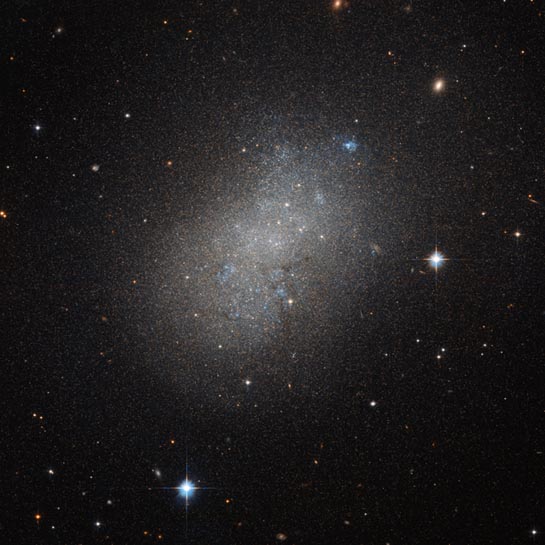
Dwarf Galaxy
RA 13h 41m 37.40s Dec -29° 54' 46.82"
Hydra
15 million light years
2.6' x 1.5'
12.4
3.22 x 3.31 arcminutes
North is 80.1° left of vertical
ESA/Hubble & NASA
August 22, 2016
ABOUT THIS IMAGE:
This image, courtesy of the NASA/ESA Hubble Space Telescope's Advanced Camera for Surveys (ACS), captures the glow of distant stars within NGC 5264, a dwarf galaxy located just over 15 million light-years away in the constellation of Hydra (The Sea Serpent). It was first discovered by John Herschel on Mar 30, 1835.
Dwarf galaxies like NGC 5264 typically possess around a billion stars - just one per cent of the number of stars found within the Milky Way. They are usually found orbiting other, larger, galaxies such as our own, and are thought to form from the material left over from the messy formation of their larger cosmic relatives.
NGC 5264 clearly possesses an irregular shape - unlike the more common spiral or elliptical galaxies - with knots of blue star formation. Astronomers believe that this is due to the gravitational interactions between NGC 5264 and other galaxies nearby. These past flirtations sparked the formation of new generations of stars, which now glow in bright shades of blue.
From Wikipedia:
NGC 5264, also known as DDO 242, is an irregular galaxy in the constellation Hydra. It is part of the M83 subgroup of the Centaurus A/M83 Group, located some 15 million light years (4.5 megaparsecs) away. The galaxy was discovered on March 30, 1835 by John Herschel, and it was described as "very faint, pretty large, round, very little brighter middle" by John Louis Emil Dreyer, the compiler of the New General Catalogue.
NGC
5264 was imaged by the Hubble Space Telescope in 2016. The galaxy is relatively
small: it is a dwarf galaxy, a type of galaxy much smaller than normal
spiral galaxies and elliptical galaxies. In fact, it is only 11,000 light
years (3300 parsecs) wide at its widest; Our own galaxy, Milky Way, in
comparison, is about ten times larger. Dwarf galaxies like these usually
have about a billion stars. NGC 5264 also is relatively blue-colored;
this is from it interacting with other galaxies, supplying it with gas
for star formation.